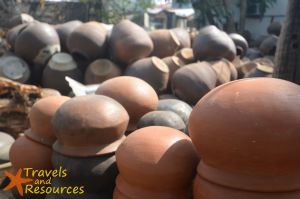 Despite the mass production brought about by casting pots in today’s industrial world, there is still quite a large demand for hand-made pottery. People from my generation may attribute this demand to the 1990 movie Ghost, where Demi Moore and Patrick Swayze had a romantic scene involving pottery making.
Despite the mass production brought about by casting pots in today’s industrial world, there is still quite a large demand for hand-made pottery. People from my generation may attribute this demand to the 1990 movie Ghost, where Demi Moore and Patrick Swayze had a romantic scene involving pottery making.
While people from other generations may have learned that the skin on the hands of pottery makers are practically flawless due to the clay used. I for one, just like the quality of the hand-made ones that come out of places like Ruby Pottery in Vigan.
Well, when I first visited Vigan decades ago, Ghost had not come out and studies on who had the most beautiful hands had not been conceived yet. I simply wanted jars from this old city because they were reputed to be some of the best in the country. And thanks to my local hosts at the time, they brought me to the Ruby Pottery where I could go crazy.
Table of Contents
Philippine Pottery
Based on information covering The New Stone Age from the National Commission for Culture and the Arts, or NCCA, indicates that the use of pottery in the Philippines may have roughly taken place at around the same time as the rest of mainland Asia, which was at around 11,000 years B.C.

Wood for Kiln
The NCCA further states that at around 6000 B.C., pottery appeared to have spread to the Northern and Southern parts of the Philippine archipelago. And by 5000 B.C., the creation of pottery was already distributed widely over the Philippines, even going as far out as Palawan. One of the best examples of this period was the Manunggul Jar from 900 B.C. and is one of the country’s national treasures.
And while the country has been making pottery for centuries, information at the Metropolitan Museum of Manila indicates that the Golden Age of Pottery in the country came much later, starting at 200 B.C. and ending in 900 A.D.
Storing food and water is considered to be the primary purpose of these jars. Thanks to their being non-porous, their contents can be expected to remain in the same amounts over time. By contrast, containers made of wood may allow fluid to seep out over time, making them less ideal for long storage.
Tracing the timeline of the NCCA, the earliest evidence of jars being used for burials goes as far back as 1500 B.C. And since pottery has already been proven to be great for storage, it was probably just a matter of time that the dead be entered in them during burial.
Ruby Pottery
Ruby Pottery is also known locally as the Ruby Jar Factory and is owned by Mr. Fidel Antiporda Go after inheriting it from his relatives. It is one of three pottery making companies in Vigan and is perhaps the biggest and, by far, the most popular.

Wood for Kiln
This was actually the place I visited and bought my jars from when I first visited the city of Vigan decades ago. And it is only now, after taking a Calesa Ride, I found it again.
Nothing much has changed since my last visit. The factory is still very traditional in the sense that it is composed mainly of stone, clay, and wood. The floor is made up of soil that has become densely packed to feel like stone over the years. Clay as raw material, as formed unbaked jars, and as baked finished jars are arranged all around the area. Wood used to fire up the kiln, or oven, can still be found piled up within the covered areas, as well as the open spaces.
Dragon Kiln

Kiln Opening
What sets Ruby Pottery apart from others is that Ruby Pottery supposedly has the largest traditional kiln in the area, maybe even the Philippines. Our guide informed us that it is called the Dragon Kiln because the length resembles the long body of a traditional Chinese Dragon.
[And I will say, this is one heck of a massive kiln!]
The top of the kiln is covered in red bricks because it is one of the few materials that can distribute and withstand the extreme temperature when it is fired up.

Dragon Kiln
After a batch of jars are finished, they are placed inside the oven through tiny holes at the sides of the Dragon Kiln. Once it is filled up, the holes are then sealed and a fire is lighted at the mouth of the oven, making it resemble a dragon even more.
The temperature is regulated by adding or subtracting firewood, as well as opening and closing holes along the sides of kiln.
I understand that cooking the jars can take several days, so someone is needed to continuously monitor the temperature to prevent the entire batch from being overcooked. One effect of using the incorrect temperature is that it can just cure the outer layer of the jars, leaving the insides soft and wet.
Jars
It’s no secret that I enjoy old houses, which is the reason why places like Vigan, Las Casas Filipinas de Acuzar, and to an extent, Fort Ilocandia Resort Hotel are close to my heart. The same goes with jars, and nothing grabs me more than those made in Vigan.

Jars
Perhaps it’s the traditional method of having to kick the pottery wheel to spin it then shape jars by hand. Maybe it is the use a type of clay that only can found in the Western side of Vigan. Or maybe it is the simplicity of the designs that grab attention without having to be loud about it.
Known as Burnay, I understand that the traditional Vigan methods and materials tend result in jars that are harder and sturdier than terracotta.
There many sizes and shapes to choose from at Ruby Pottery. Apart from decoration, many people still use it to cook food and store water. In fact, there is just the right size for a tabo, or dipper.

Jars
Apart from water, Burnay Jars are still used to store salt, sugar, and the local wine Basi. It is also used to create Bagoong, while is the delicacy of fermented fish.
These jars are also the preferred materials in the creation of rock salt. What some people along the coastal areas do is buy cracked Burnay Jars by the bag. These concave pieces of ceramic are then scattered around the area where rock salt can be harvested. As the tide goes down, the rock salt is attracted to the Burnay pieces, making it easy to scoop them up and shake them into salt bags.
Final Thoughts

Pottery Table
It has been decades since my first visit to Vigan. Since that time, I have literally been trying to find Ruby Pottery on my own. Unfortunately, the lack of time meant that I could not try and retrace the path I took all those years ago.
In our last trip, my wife and I finally decided to take the Calesa around town. And one of the stops on the tour was the Ruby Pottery.
I came out with a few small and medium-sized jars for plants at home. I would have purchased more, had my wife not pointed out that the ones I had lined up were too big to fit in our vehicle.
[Oops! Almost made a big blunder there.]
Well, time for me to head out. I hope you can join me for upcoming articles as we explore the real Vigan.
Must Do’s
- Try making a jar through the traditional method.
Must Don’ts
- Do not leave children unattended as the items here are breakable.


Comments are closed